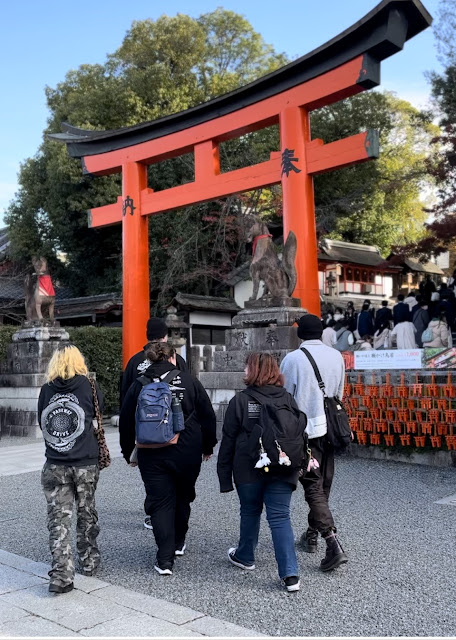12/1/2023
Fushimi Inari Shrine (Fushimi Inari Taisha), Kinkakuji Temple
Fushimi-Inari-Taisha enshrines the god Inari, which is the god of the rice harvest, commerce, and business. The messenger of the god Inari is the fox. The key in their mouth represents the key to the rice storehouse in ancient times.
Since it was university entrance exam season, the long line of students who studied and those who should have were wrapped around the building.
Two stone lanterns are holding round rocks behind and to the right of the main hall of the inner shrine. These rocks are the Omokaru Ishi, and they are an unusual way of making a wish. After a person makes a wish, they try to lift one of the rocks. Supposedly, your wish will come true if you can pick up the chosen rock. If not, you're out of luck.
I have a strange feeling this group should have studied longer.
We explored the Nishiki Market, AKA "Kyoto's Kitchen," a five-block-long row of shops and restaurants showcasing fresh produce, seafood, cookware, wine, baked goods, and almost everything imaginable.
Miki gave us 500 Japanese Yen ($3.50) and then challenged us to find, buy, photograph, and taste something unique. She gave us about 45 minutes, including time for our own lunch. Being the competitive person I am, I took off to get away from the group in search of the weirdest food I could find...
How about a candied-grilled octopus inside a quail egg?
I was sure this had to be a winner, but Stan and Paula also chose it, and I forfeited because I refused to take a bite out of it. In the end, Mica broke their tie with a win.
I recovered by having a delicious 4-cheese pizza and two beers for lunch, so the day was not a total loss.
Kinkakuji Temple, a UNESCO World Heritage Site, is known for the Temple of the Golden Pavilion, an architectural gem dating back to 1387 when it was built by the third shogun (military commander) of the Ashikaga Shogunate.



















No comments:
Post a Comment